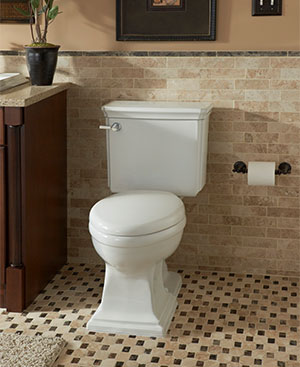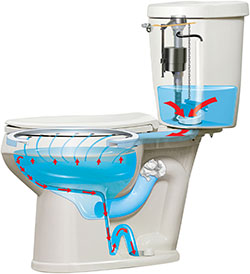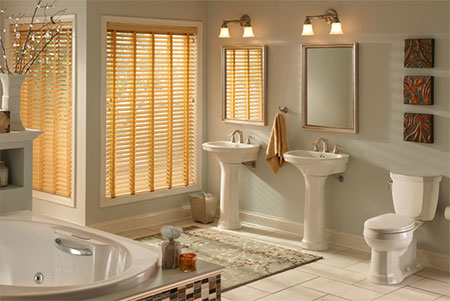Flush with Success: 3 Key Tips for Selecting Toilets
by Kathy Ziprik, Staff Writer
Every home buyer is different. They come to you with their own dreams and ideas. Your role is to guide them with your expertise and craft a home they'll love.
Your experiences have most likely aligned you with products that you have confidence in and feel comfortable recommending to your clients. And, when it comes to the bathroom, who doesn't want to feel comfortable in their own home?
But before you make your sanitaryware recommendations to your clients, consider these two statistics. First, according to Credit Sesame, the average homeowner sells their home after just nine years. Second, the Population Reference Bureau estimates there are about 76.4 million baby boomers in the U.S.—and they're all at or approaching retirement age.
How do these two pieces of information impact your role as a builder? The answer is that while your new home buyers are excited to construct and live in their dream home, it's possible their life there will be relatively short-lived.
You can play a valuable role by guiding them toward installing products that will position their home for exceptional resale potential in the future, while giving them enjoyment now. That means constructing bathrooms that are suitable for current pleasure while still keeping in mind usage by a potentially different demographic audience in the future.
"Aging baby boomers are a large audience that will need bathroom products that comply with ADA standards to make their lives safer and more comfortable," says Jean Dimeo, a Certified Aging in Place Specialist (CAPS). "Taller toilets that are easier to get up from, pedestal sinks that allow wheelchairs and walkers to come right up next to, and walk-in tubs that allow easy in-and-out access are all examples of products that people may need in their bathrooms as they grow older."
Tip #1: Seek out manufacturers offering a wide variety of ADA-compliant sanitaryware products for your new home projects.
"Having a product that is ADA-compliant doesn't mean a person has a disability or is in a wheelchair," says Adriana Miller, product manager for Mansfield Plumbing. "Even young baby boomers may find they can benefit from a taller toilet, like a SmartHeight™ toilet. These toilets are about two to three inches higher than a standard toilet, allowing people to get up and down from the seat much easier."
While vanity sinks with storage below may seem like the ideal scenario at first, make sure to offer your customers options such as pedestal, under-counter and wall mounted sinks. These sinks offer more space in the bathroom and comply with ADA requirements for accessibility.
"Creating a bathroom to meet the future needs of a homeowner (or the person they sell their home to in the future) doesn't mean giving up style," says Miller. "Function can indeed be matched up with style when selecting the right products."
The design of the
Protector® Toilet eliminates messy overflows by redirecting waste water into a secondary drain when the primary trapway is clogged.
Tip #2: Save your clients headaches related to clogged toilets.
There are many aspects you probably base a toilet purchase on—reliability, ease of installation, style and functionality.
From a homeowner's perspective, think fewer headaches. You can earn their unending gratitude if you select a no-overflow toilet that eliminates smelly, unsightly and messy overflow situations.
A new product in the marketplace, the Protector® No-Overflow Toilet, solves the problem of clogged toilets by redirecting overflowing water into a concealed secondary drain. There are no unsightly holes and the overflow system is hidden within the bowl.
Available as a SmartHeight toilet, the Protector sits 16-1/2" tall and meets ADA standards, making it easy to sit and stand from this easy-access toilet. For powerful flush action, the toilet also features a three-inch flush valve design and has a maximum performance (MaP) rating of 800 grams.
As a bonus, in addition to solving the "clogging overflow dilemma," the Protector stays clean longer than standard toilets. A highly engineered PuraClean™ glaze on the toilet makes the bowl bacteria resistant and easier to clean.
The
Montclair™ Suite features classic design elements that address modern concerns. The pedestal sinks pictured here open the space for easier movement, and the toilet is ADA-compliant and uses only 1.28 gallons per flush.
Tip #3: Go green with toilets and put money back in your clients' wallets.
Want to impress your clients? Tell them you're recommending toilets that will save on their water bills every single day.
By choosing toilets with the WaterSense® label, you're making a conscious decision to put toilets in your homes that are certified to be at least 20 percent more efficient without sacrificing performance.
"Typically a WaterSense labeled toilet uses 1.28 gallons per flush (Gpf) or less," says Miller. "This is reduced significantly from older style toilets that can use up to 3.5 Gpf. Using less water, with a more powerful flushing system, can really help make a difference on the water bills for a family."
Want to really impress your clients? Then get the numbers on exactly how much they can save by investing in different types of toilets. Visit the Water Savings Calculator at the Mansfield Plumbing website and you can swiftly calculate the savings. For example, a family of five can potentially save 20,257 gallons of water a year using a 1.28 Gpf toilet, which can equate to an estimated $80 savings in water bills.
By offering headache-free, water-saving toilets that are valuable for your customers now and in the future, you can position yourself for more referrals and become "flush with success!"



.png)
.png)




